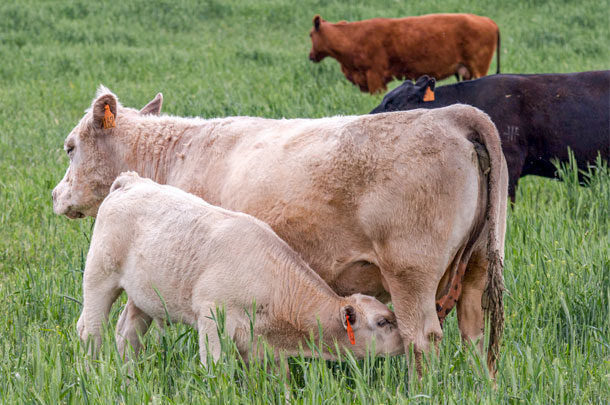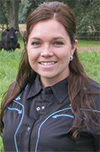“How do you know how much to feed your cows, that’s based on weight, right?” he stated. I went on to try to explain how oftentimes, mature cows are not weighed on a regular basis, and about halfway through me making excuses for poor management practices, he stopped me to say, “You’re telling me cattlemen base a huge part of their herd’s management off of your educated guess!”… Yes sir, we do, and no sir, no, we should not. While in the cattle industry this is a common practice, on other fields of agriculture, or business for that matter, this is insane, yet we are all guilty of it.
The pound is a critical thing in the cattle industry. Cattle producers get paid by the pound, all feed and commodities are bought by the pound, and the pound is the primary indicator of performance. While cattle producers often think in “pounds” on a daily basis, mature cow weights are frequently estimated instead of determined by a scale.
Taking the time to weigh your mature cows can have a significant impact on your ability to fine-tune your herd management strategies. And while many producers feel they are accurate enough at guessing mature cow weight, and some are, there is a large subset of producers who still assume they are running 1,100-pound mature cows. Let’s face it, with today’s genetics and phenotypes, those 1,100-pound cows are about as common as a unicorn in West Texas.
Taking the time to weigh mature cows gives producers the opportunity to fine-tune their management strategies. There is a plethora of reasons why mature cows should be weighed on a regular basis. Here are three reasons to consider:
Stocking rate
Cattle producers are working overtime to maximize their bottom dollar, and maximizing their carrying capacity on their range or pastures is critical to managing fixed costs such as land. Therefore, when calculating the land’s AUMs (animal unit month: total feed required for a 1,000-pound cow and her calf [up to 6 months] for one month) to determine the carrying capacity, over- or underestimating mature cow weight can dramatically impact your stocking rate.
For example, if you assume your mature cow size is 1,100 pounds, when in fact you are running 1,300-pound cows, you would be overstocking your grazing lands. And on the flip side, if you are underestimating by just 100 pounds, for every 11 to 12 head, you could add an additional animal unit to your stocking rate.
The bottom line is when it comes to stocking rate, having an accurate weight on your mature cow herd is critical. North Dakota State University (NSDU) has developed a great worksheet for calculating stocking rate that can be found at the NSDU website.
Performance records
A majority of all performance records that are kept by cow-calf producers are based off of weight. In most cases, producers are able to easily collect weight records for calves, whether these are coming from individual weights or sale day averages. These weights are critical in determining the overall performance of your herd. However, they must be tied back to mature cow weight to determine overall efficiency.
For example, when you are looking at weaning weight, one might assume the herd that averaged 600 pounds on their steers was superior to the herd that averaged 525 pounds. However, when you take into consideration that the 525-pound calves were weaned off of 1,200-pound cows versus the 600-pound calves that came off of 1,600-pound cows (yes, they are out there), the overall efficiency of the two herds is dramatically different. Ideally, individual cow weights would be collected so percent bodyweight weaned can be determined, but having an accurate mature herd average is still better than an estimate.
Calculating animal performance is often what comes to mind, but having an inaccurate weight of animals also makes it difficult to track the performance of the range and pasture lands that we are managing. Knowing the total number of pounds per month that a pasture can support will allow for proper stocking and evaluation of forage production. In many parts of the U.S., fertilizer and feed are the two highest annual costs. If a producer is not able to determine the total pounds of cattle that acre is supporting per month, investments in fertilizer cannot be managed.
Drug dosing
Whether you are treating for foot rot or administering some type of parasite control (dewormer) to your herd, you are calculating your dosage based on bodyweight. Typically, the rule of thumb for this is to guess the bodyweight of the animal, add 300 pounds, round up and dose accordingly. (Be honest, we have all done it.) However, this is far from best management practices. In the case of dewormers, underdosing cattle is leading to drug resistance. The parasites are exposed to the drug, however, not at a rate high enough to kill them. This creates resistance as the most susceptible parasites are dying, while more resistant ones are surviving and reproducing. In addition, research has shown that overdosing does not result in increased control, thus is a waste of money.
The same theory applies to antibiotic dosage. Just like your doctor stresses that you must take the entire bottle of antibiotics, it is critical that we are dosing our cattle for the right weight. Underdosing will allow for the pathogen we are treating to be exposed to low levels, over a period of time, and this too can decrease the effectiveness of treatment and result in pathogen resistances. In addition, proper dosing is critical for withdrawal times.
At the end of the day, taking the time to collect weights on your mature cow herd will be nothing but beneficial to the management of your operation. In a day and age when the profit margins in the beef industry are constantly being challenged, it is sometimes the simplest practices that can have the largest returns. ![]()
PHOTO: When it comes to stocking rate, having an accurate weight on your mature cow herd is critical. Staff photo.

-
Kalyn Waters
- Agricultural Agent
- University of Florida Extension
- Email Kalyn Waters







